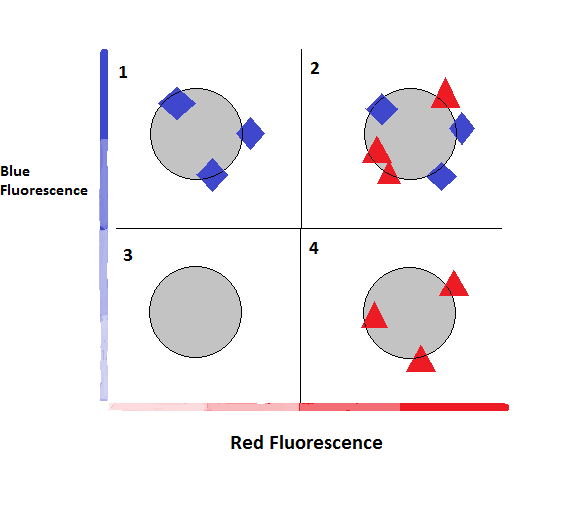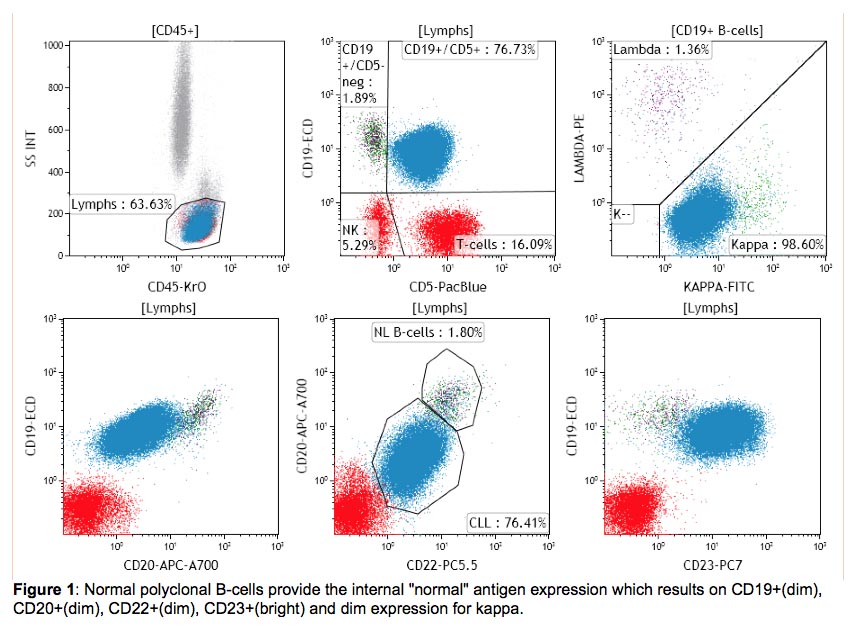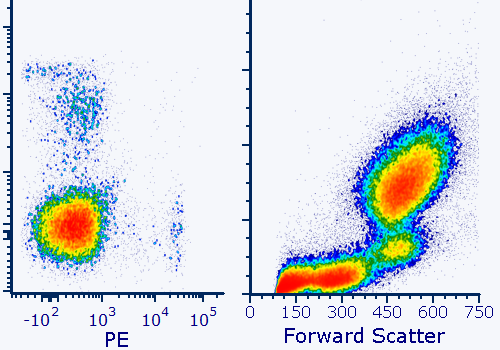flow cytometry results meaning
Flow cytometry is so refined that individual proteins can be tracked. In aquatic systems flow cytometry is used for the analysis of autofluorescing cells or cells that are fluorescently-labeled with added stains.

Data Calibration A Scatter Plot Of Flow Cytometry Forward Scatter Download Scientific Diagram
Flow cytometry immunophenotyping is used primarily to help diagnose and classify blood cell cancers leukemias and lymphomas and to help guide their treatment.

. The light produced by lasers in a flow cytometer is scattered by cells in the sample measured by detectors and then translated to signals that can be analyzed and measured. Flow cytometry is a method for analysing cells used by immunologists and man. Results from the flow cytometry show the detected CD numbers which doctors use to compare to regular and irregular cells allowing them to form a diagnosis.
Flow cytometers utilize properties of fluid dynamics to send cells one at a time through a laser. Other Words from flow cytometry Example. This is what you need to know about Flow Cytometry and FACS.
This information will help the reader assess the strength of any results. It may be used in follow up to a complete blood count CBC and WBC differential that show an increased number of lymphocytes or the presence of immature blood cells or other abnormal. This point is either a valley or one of the signal endpoints.
Of greater value is flow cytometry as a fast and reliable method to distinguish between AML and ALL which is an important decision. As a laser-based technology flow cytometry is largely dependent on the light-scattering properties of cells and particles that make it possible to analyze such characteristics as the size of cells DNA content within a cell as well as cell granularity among. Through the use of various reporter stains fluorescence-based being the most.
This is the Minimum Information for a Flow Cytometry Experiment or the MIFlowCyt standard. Ad Analyze Blood Cultured Cells Bacteria Algae Yeasts Microparticles and Nanoparticles. Flow cytometry is a technique used to analyze cells for a variety of purposes including cell counting phenotyping cell cycle assessment and viability.
As cytometrists we have a tool that can be used to help improve the communication of experimental information. However usually this can be done with microscopy as well and in some cases even better. This research started in 1981 when Clarice Yentsch used flow cytometry to measure the fluorescence in a red tide producing dinoflagellate.
Easy-to-add into multi-color experiments. Using a laser and fluorescently tagged proteins parameters such as cell size health and phenotype can be determined. Todays flow cytometers are capable of processing 100000 cellss and analyzing up to 70000 cellss with this threshold getting higher every year.
In essence results for the same sample can be very different as described below depending on whether the data for the sample are collected and displayed with the older or newer methods. The flow cytometry results are. The use of flow cytometry has increased over the years as it provides a rapid analysis of multiple characteristics both qualitative and quantitative of the cells.
Definition of flow cytometry. A technique for identifying and sorting cells and their components such as DNA by staining with a fluorescent dye and detecting the fluorescence usually by laser beam illumination. Flow cytometry is used extensively throughout the life and biomedical sciences and can be applied in any scenario where a researcher.
Flow Cytometry is a process used to analyze cell characteristics. MIFlowCyt standard and the Flow Repository. First flow cytometry can help detecting an acute leukemia.
This information is based on physical characteristics andor markers called antigens on the cell surface or within cells that are unique to that cell type. This method may be used to. Flow cytometry is a standard laser-based technology that is used in the detection and measurement of physical and chemical characteristics of cells or particles in a heterogeneous fluid mixture.
A percentage count of a sub-population of cells. Reaches the left or right end of the signal. Flow cytometry provides a well-established method to identify cells in solution and is most commonly used for evaluating peripheral blood bone marrow and other body fluids.
The development of. Flow cytometry is a laboratory method used to detect identify and count specific cells. Flow cytometry studies are used to identify and quantify immune cells and characterize hematological malignancies.
This method can also identify particular components within cells. Value of flow cytometric analysis. Value of flow cytometric analysis.
A flow cytometry test can tell your medical team how aggressive your condition is how likely it is that a certain treatment will work and how likely your condition is to relapse after treatment is complete. Flow cytometry is a technology that rapidly analyzes single cells or particles as they flow past single or multiple lasers while suspended in a buffered salt-based solution. While flow cytometry generally gives the percentage of a particular sub-set of cells some flow cytometers precisely record the the volume of sample analysed or deliver a fixed volume of sample.
Flow cytometry is unique in its ability to measure analyze and study vast numbers of homogenous or heterogeneous cell populations. In fact disputes can arise over what might seem to be incom-patible data but the contradictions could simply reflect unrecognized differences in. Flow cytometry is one of the most popular laser-based technologies used to study a variety of cell and particles characteristics.
When talking about your potential treatment all of. Find the minimum of the signal in each of the two intervals defined in Step 2. Interpretation of flow cytometry data plots.
Thus we can analyze a cells inner workings and signaling networks. Each particle is analyzed for visible light scatter and one or. Flow cytometry is a particularly powerful method because it allows a researcher to rapidly accurately and simply collect data related to many parameters from a heterogeneous fluid mixture containing live cells.

Data Analysis What Does A Histogram For Flow Cytometry Tell Me Unsolved Mysteries Of Human Health Oregon State University

How To Identify Problems With Flow Cytometry Experiment Design Bad Data Part 3 Cytometry And Antibody Technology

Practical Guide For Live Cell Cycle Analysis In Flow Cytometry Nordic Biosite

How To Identify Problems With Flow Cytometry Panel Design Bad Data Part 2 Cytometry And Antibody Technology

Dot Plot Representing Four Quadrant Images Observed By Flow Cytometric Download Scientific Diagram

Blog Flow Cytometry Data Analysis I What Different Plots Can Tell You

How Do I Confirm False Positives In Flow Cytometry

International Clinical Cytometry Society

Flow Cytometry An Overview Sciencedirect Topics

What Are The Uses Of Flow Cytometry Enzo Life Sciences

Chapter 6 Dna Analysis Flow Cytometry A Basic Introduction

Cell Cycle Distribution Measured By Flow Cytometry Cell Cycle Arrest Download Scientific Diagram

Fold Mfi Vs Change In And Cells Which One Is Better Way Of Representing A Histogram For A Fluorescent Event Measured By Flow Cytometry Why

1915 Questions With Answers In Flow Cytometry Scientific Method

Blog Flow Cytometry Data Analysis I What Different Plots Can Tell You

How To Identify Problems With Flow Cytometry Experiment Design Bad Data Part 3 Cytometry And Antibody Technology

Representative Data For Flow Cytometry Analysis Of T Lymphocyte Subsets Download Scientific Diagram

How Would You Explain Cell Populations With Negative Values In Flow Cytometry Plots
